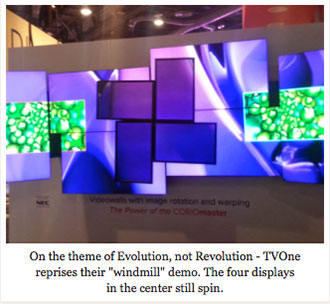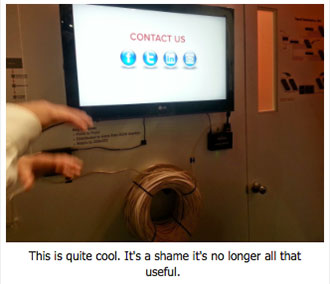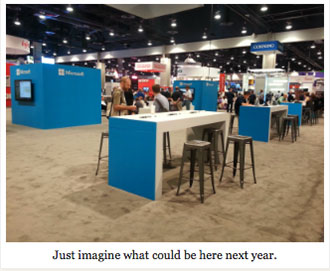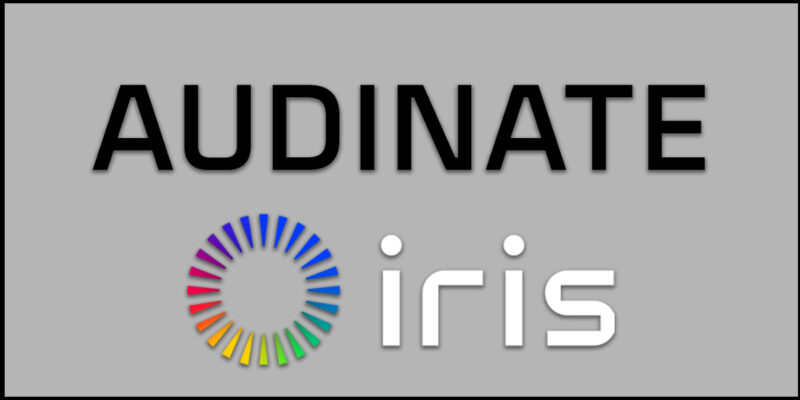Infocomm Wrap-up, Part the Fourth — Hits and Misses
A week past my return from InfoComm, I’m finally getting to write my overall reflections on the show and what technology I saw there. For further perspectives, visit my esteemed colleague Alex Mayo, who offers his own perspective. Alex is a bright man and a very talented designer with whom I’m quite fortunate to work. I especially agree with him on the growing role of enterprise-wide resource management and analysis as part of our projects.
Before I start, I’d like to tip my hat to Draper, to Corey Moss, to George Tucker, and to everyone else who added their voice to the discussion of “booth babes” and the larger topic of sexism in the industry. This is a conversation that isn’t over by a long-shot, and it’s my sincere hope that we keep it up and see some changes next year. Now, on with the show!
 Overall, InfoComm this year was fun and informative, but it wasn’t a year that felt important in that it would change how we think about AV. Much of it felt evolutionary to me, as existing product lines were refined and expanded upon but few really new and daring changes came. Here are some hits and misses, along with my reflections.
Overall, InfoComm this year was fun and informative, but it wasn’t a year that felt important in that it would change how we think about AV. Much of it felt evolutionary to me, as existing product lines were refined and expanded upon but few really new and daring changes came. Here are some hits and misses, along with my reflections.
Hit: Network-Centric AV
It’s been quite some years since vendors such as SVSI started selling JPEG2000 encoded video as a transport and routing solution. It certainly is feeling to me that the time for this technology has finally come now that we have greater IT/AV convergence, proliferation of higher-bandwidth lower latency networks, and — perhaps most importantly — changes to workflow and overall expectations. SVSI has expanded their uncompressed video over network line to include 4K and has also expanded their control and video-wall processing offerings. ClearOne, Aurora Multimedia, Crestron, AMX and others have all thrown their collective hats in the ring, with solutions including H.264, JPEG2000, and/or uncompressed video offerings. Crestron’s introduction of an H.264 card (not an InfoComm introduction, but new for this year) is an elegant solution for hybrid designs in which in-room transport is handled by more traditional means.
The best part of this is the number of technologies being deployed. Uncompressed video is critical in latency-sensitive environments such as annotation. Compressed video solutions — most of which are configurable for different levels of quality and bandwidth — are excellent for campus-wide distribution, while uncompressed video is still a requirement for highly latency-sensitive control and annotation applications.
Miss: HDBaseT, Other Video Over Structured Cable
This wasn’t a miss in that it’s bad technology; I still use this kind of solution in nearly every AV system I design. What makes it a miss for me at the show is that the technology seems to have plateaued. Yes, we can now send 4K content over copper and that’s a big plus. With relatively little content available, 4K is still a little bit of a niche technology. Does it remain something for which we need to prepare? Absolutely. Does 4K capability offer real utility in 90 percent of AV systems? Not really.
 For a “near miss” see the demo by TVOne division Magenta Research of 1080p content over an entire spool of category cable. This is quite impressive, especially for those of us who’ve sometimes struggled with marginal signal over long cable runs. The problem is that it seems like yesterday’s technology; if I have an endpoint an entire cable-spool away from its source, I’d far more likely use a network-based solution. The geek in me finds this really cool; the designer in me is not sure I’ll ever use it.
For a “near miss” see the demo by TVOne division Magenta Research of 1080p content over an entire spool of category cable. This is quite impressive, especially for those of us who’ve sometimes struggled with marginal signal over long cable runs. The problem is that it seems like yesterday’s technology; if I have an endpoint an entire cable-spool away from its source, I’d far more likely use a network-based solution. The geek in me finds this really cool; the designer in me is not sure I’ll ever use it.
Hit: Direct-view LED Displays
Some of the biggest buzz was over direct-view LED displays, especially Christie’s Velvet, with a 2 millimeter pixel pitch and Silicon Core’s Magnolia at 1.5 millimeter. This is very, very impressive and lets viewers get very close to the display before the image appears to break up to a series of dots. Aside from obvious applications in outdoor displays, this technology has finally reached the point at which it’s tempting for a boardroom or conference room application — especially if the alternative involves taking apart the side of a building to fly in a piece of rear-projection glass.
Miss: Complicated Hardware Control Appliances
The above-mentioned Mr. Mayo stated his lack of interest in proprietary touch panels. His argument is that consumer-grade tablets — especially the fruit-flavored ones from Cuppertino — have as much if not more capability at a fraction of the cost. We’ll soon reach the point at which we can extend that to control processors. I got a peek at the new processors from AMX, and found them a bit time-warpy. They have a nice, low-profile 1RU controller with a ton of serial, IR and relay ports on the back of it. This would be wonderful a few years ago, but today I see more and more IP-based control and less and less RS232. I’ll say the same about new touch panels from Crestron. Are they improving? Yes. Do they match the capability and cost of an iPad? Not at this point.
Hit: Web Control and Monitoring
I had a brief chat with departing Vaddio CEO Rob Sheeley who showed off an integrated webserver in Vaddio’s new RoboShot line of pan/tilt/zoom robotic cameras. This removes perhaps the last major use of RS232 from many projects. It also opens the possibility of adjusting camera settings via a remote interface rather than from the rack-mounted camera control unit. Very much a welcome change and improvement. That the camera itself has a slick, modern design doesn’t hurt.
Hit: Wireless Collaboration/Video Streaming
Not only are these proliferating, they’re getting better. On the simpler end, we have the WePresent/Clickshare CSM/Airmedia family. There is also the software-only product from Mersive, which was already impressively responsive before a recent software upgrade. Rounding out the appliance side are the Wow Vision/Kramer product and the AMX Enzo. Now that Enzo has added Miracast and Apple screen-mirroring support, these are both viable solutions in this space. What makes them more appealing is that each has the ability to run secondary applications — Windows 7 programs in the case of Wow Vision and what appears to be a Java-based system for AMX. This is what caught my interest when Enzo was first introduced last InfoComm, but as of that time the only app available was Dropbox. With the introduction of screen mirroring AND the promise of Lync/Skype integration by the end of the year, Enzo has gone from an expensive Dropbox machine to an intriguing solution for small collaborative soft-conferencing oriented spaces. I look forward to seeing more.
Soft hit: Dante
We’ve seen the 150th Dante licensee, Kramer Electronics, with a set of small (half-rack) amplifiers. ClearOne, after depending solely on its proprietary G-Link, not only is adding Dante to its Converge product line, but is also now producing a 512×512 Dante-based DSP. Audinate itself launched Via, a nice expansion on the concept of the existing “Virtual Soundcard.” Via recognizes all of the audio I/O capabilities of a computer (including both software options such as music players or soft Codecs AND hardware options including speakers, mics and embedded audio on HDMI) and will allow them to be explicitly displayed as inputs or outputs on Dante Controller. Having direct access to applications as well as physical I/O is a very interesting change; I look forward to finding ways to take advantage of this new capability.
Miss: AVB
When I mentioned AVB to one of my colleagues, he had one question for me: “Is it dead yet?” I don’t think it quite is, but it is, at best, on life-support. Crown Audio (as well as the rest of the Harman family) supports AVB, as do a handful of other endpoint manufacturers. Biamp now has AEC available in an AVB-enabled expansion box, but that’s about it for the exciting AVB news; it has nowhere near the robust ecosystem which has grown around Dante. In fact, I can’t think of anything I could do at this point with AVB that I couldn’t do more easily in a Dante system. Mark Coxon may see it as the great big promise for Harman; I’m not quite ready to stick a fork in it and declare it “done” but, at least as an audio-transport medium, I’m very, very close.
 Overall
Overall
This was a nice show, but not a dazzling one; I walked away with, as usual, some interesting ideas and thoughts but nothing which radically changed my thinking on anything in the industry. The industry continues to move, yet at a slow pace. Most symbolic of that, perhaps, was the much-discussed Microsoft booth. Microsoft arrived to display… nothing very much. Some charging stations, displays and the promise of white space and what may fill it tomorrow.





